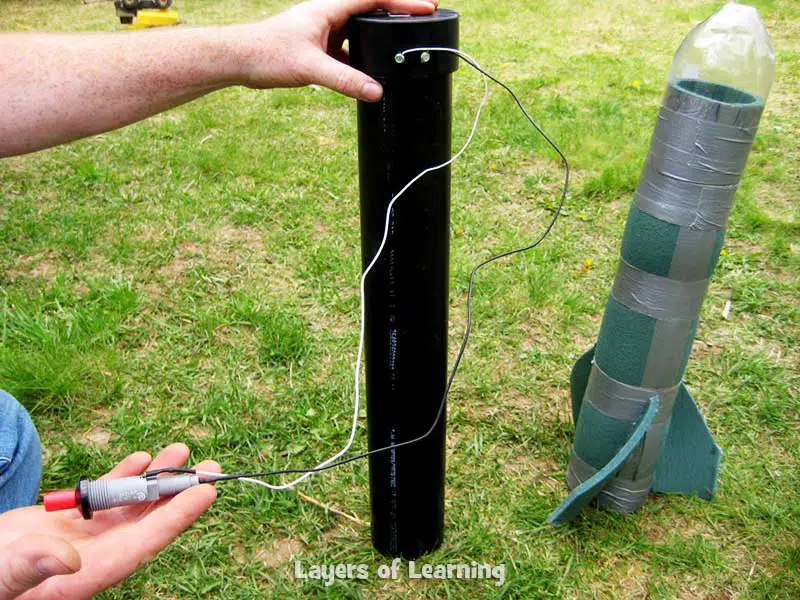This exploration is for all ages, as the colored smilies show. All ages of kids except the oldest teens will need to do this project with an adult helping. You can build a PVC rocket with your whole family!




The PVC rocket is a chemistry experiment from Gases. Layers of Learning has hands-on experiments in every unit of this family-friendly curriculum. Learn more about Layers of Learning.
This PVC rocket is propelled with hairspray, which has a high alcohol content. The hairspray is sprayed into a chamber and then ignited. A little spark inside the chamber causes an explosion of rapidly expanding gases. The foam sleeve over the top of the ignition chamber flies up into the air.
Step 1: Library Research
Before you begin exploring and building your PVC rocket, read a book or two about motion. Here are some suggestions, but if you can’t find these, look for books at your library about motion, physics, gravity, and friction. The colored smilies above each book tell you what age level they’re recommended for.
As Amazon affiliates, the recommended books and products below kick back a tiny percentage of your purchase to us. It doesn’t affect your cost and it helps us run our website. We thank you!

How Does a Rocket Work?
by Sarah Eason
Step 2: Build A PVC Rocket
You will need 4″ PVC pipe (3 feet long), 4″ PVC cap, PVC glue or superglue, foam (the kind used for sleeping mats), plastic 2 liter bottle, duct tape, screws, power drill, barbecue grill ignition switch, hot glue gun and glue, cheap hairspray (the more alcohol the better), and scissors.



This is what the finished ignition chamber and rocket will look like.

Start by making the foam rocket. Wrap the foam around the PVC pipe, trim it to fit and use copious amounts of duct tape to secure it. Then cut the top of a 2-liter bottle (keep the cap on!) and tape it to the top of your foam rocket. Next, cut three fins and hot glue them to the base of the rocket. The fins will help the rocket fly higher and straighter.
Next, assemble the ignition chamber. Glue the cap on to the end of the PVC pipe with PVC glue or superglue. Drill two holes about an inch apart, but angling slightly toward one another. The curve of the PVC pipe itself should take care of that angle you need. What you want is for there to be a tiny gap between the ends of the screws inside the PVC pipe.
Insert the screws most of the way into the PVC pipe through the holes you pre-drilled. Wrap bare ends of the wire from the barbecue ignition switch around the screws, then tighten the screws slightly so the wires won’t slip off.

Next, you spray hairspray into the top of the ignition chamber (the PVC pipe). Slide the rocket over the top and stand it upright. Click the barbecue lighter to create a spark and . . . liftoff!
Step 3: Show What You Know
Finally, talk about the way the explosion is rapidly expanding gases that have to go somewhere. The only place to go is up, so the gases push the rocket into the sky.
Additional Layers
Additional Layers are extra activities you can do or tangents you can take off on. You will find them in the sidebars of each Layers of Learning unit. They are optional, so just choose what interests you.
Additional Layers
This experiment uses the diffusion of gases. Usually we think of diffusion as a slow process, but in this case, it is very fast.

Learn more about diffusion.
On the Web
Normally rockets use fuel to push gas out the back end and off the ground. This “rocket” is different because the fuel is pushing the vehicle up while the rocket itself stays on the ground.
Additional Layers
Why does the rocket need fins?
To fly high, a rocket must fly straight. To fly straight it needs fins to stabilize it.

Try building a foam rocket body that doesn’t have fins. What happens when you launch it?
Get a Free Unit
Choose between the first unit in each Layers of Learning subject to try for free when you sign up for the newsletter.
We never spam and you can cancel your subscription at any time.











Hi,
I was wondering if you could tell me where you purchased the thin foam pad that you used for the hairspray rockets?
It is a sleeping mat for camping. We had extra ones lying around. Look for “EVA foam sheet” that is about 10 mm thick or so.